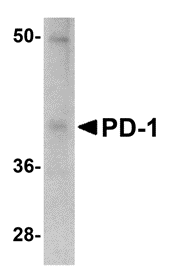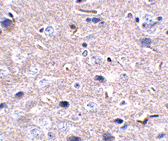Catalog# : PM-5179
Cell-mediated immune responses are initiated by T lymphocytes that are themselves stimulated by cognate peptides bound to MHC molecules on antig en-presenting cells (APC). T-cell activation is generally self-limited as activated T cells express receptors such as PD-1 (also known as PDCD-1) that mediate inhibitory signals from the APC. PD-1 can bind two different but related ligands, PDL-1 and PDL-2. Upon binding to either of these ligands, signals generated by PD-1 inhibit the activation of the immune response in the absence of “danger signals” such as LPS or other molecules associated with bacteria or other pathogens. Evidence for this is seen in PD1-null mice who exhibit hyperactivated immune systems and autoimmune diseases. Despite its predicted molecular weight, PD-1 often migrates at higher molecular weight in SDS-PAGE.
Additional Names : PD-1 (12A7D7), Programmed cell death 1, PDCD-1, CD279
 Description
DescriptionLeft: Western blot analysis of PD-1 in A-20 cell lysate with PD-1 antibody at 1 µg/ml.
Below: Immunohistochemistry of PD-1 in mouse brain tissue with PD-1 antibody at 2.5 µg/ml.
Other Product Images
 Source : Mouse monoclonal PD-1 antibody was raised against an ~150 amino acid recombinant protein from near the terminus terminus of mouse PD-1.
Source : Mouse monoclonal PD-1 antibody was raised against an ~150 amino acid recombinant protein from near the terminus terminus of mouse PD-1.Purification : Immunoaffinity chromotography purified IgG
Clonality and Clone : This is a monoclonal antibody. (Clone 12A7D7)
Host : PD-1 monoclonal antibody was raised in mouse. Please use anti-rabbit secondary antibodies.
Immunogen : A ~150 amino acid recombinant protein from near the terminus terminus of mouse PD-1.
Application : PD-1 antibody can be used for detection of PD-1 by Western blot at 1 – 2 µg/ml.
Tested Application(s) : E, WB, IHC
Buffer : Antibody is supplied in PBS containing 0.02% sodium azide.
Long-Term Storage : PD-1 monoclonal antibody can be stored at 4ºC, stable for one year.
Positive Control
1. Cat. No. 95-115 - PD-1 Recombinant Protein
Species Reactivity :H, M, R
Short Description : Programmed cell death 1
References
1. Holling TM, Schooten E, and van Den Elsing PJ. Function and regulation of MHC class II molecules in T-lymphocytes: of mice and men. Hum. Immunol. 2004; 65:282-90.
2. Ishida Y, Agata Y, Shibahara K, et al. Induced expression of PD-1, a novel member of the immunoglobulin gene superfamily, upon programmed cell death. EMBO J. 1992; 11:3887-95.
3. Zhong X, Bai C, Gao W, et al. Suppression of expression and function of negative immune regulator PD-1 by certain pattern recognition and cytokine receptor signals associated with immune system danger. Int. Immunol. 2004; 16:1181-8.
4. Nishimura H, Nose M, Hiai H, et al. Development of lupus-like autoimmune diseases by the disruption of the PD-1 gene encoding an ITIM motif-carrying immunoreceptor. Immunity 1999; 11:141-51.

No comments:
Post a Comment